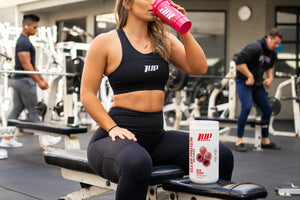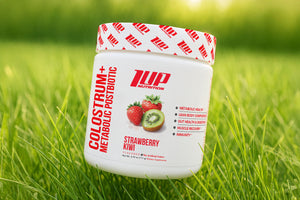Technology has afforded us many benefits and luxuries in life.
You can track your sleep, check on your doggie-cam on your phone, and even order groceries to be delivered to your door without ever leaving your couch.
Regarding fitness, there’s a never ending funnel of gadgets and gizmos to help you build muscle, lose fat, and get results.
But, more often than not, you don’t need to worry about the latest fitness doo-hickey to improve the results during your transformation challenge. You need to focus on the basics -- training hard, eating right, and getting enough sleep.
And, one of the simplest (and most affordable) pieces of equipment you can use to improve your results is a food scale.
Here’s why a food scale is your weight-loss secret weapon.
4 Benefits of Using a Food Scale
#1 Know Exactly How Much Food You’re Eating
In order to efficiently lose weight, you need to consume fewer calories than your body requires to maintain its weights (aka a calorie deficit). The only way to know with relative certainty whether you are in a calorie deficit or not is to track your nutrition.
Keeping a food journal is part of the solution, and shown in research to be vital to helping individuals reach their goals.[1,2]
However, logging your food is only as accurate as your ability to measure how much food you’re actually eating.
And, the best way to know exactly how much food you’re eating is to use a food scale.
By weighing your portions of food, you know exactly how many calories you’re consuming, as well as how many carbohydrates, protein, and fat each meal contains (which is important for those tracking macros as well as total calories).
#2 You Learn Portion Sizes
As you gain more experience with a food scale, you’ll gain a better grasp of portion sizes, which will help you learn how to eyeball portion sizes so that down the road you won’t always have to rely on the food scale to know how much of what foods you’re eating.
The goal of long-term sustainable healthy eating habits isn’t to be married to a food scale for the rest of your life. It’s to help you learn what appropriate portion sizes are for your goals and needs, and if you ever need to fine tune things to a very specific degree (such as getting ready for a physique competition or photo shoot), you can always pick it up to fine tune your intake.
#3 Improve Cooking & Baking Skills
It’s often said that cooking is an art and baking is a science. What that means is that cooking dishes (usually on the stovetop) can be done “touch and go”. You start cooking a dish, taste it, and tweak seasonings and spices as the dish cooks.
However, with baking, you get one shot. If you’re off by just the slightest ¼ teaspoon, the whole concoction could be off.
Using a food scale ensures that your measurements are always correct so that you never over or under dose an ingredient.
For the meticulous gastronomes out there that love to cook all of their meals, you too can benefit from a food scale to make sure you’re adding proper amounts of seasonings and spices to your breakfasts, lunches, and dinners.
Food scales are also helpful for making protein waffles or protein pancakes using 1UP whey protein as well as other quick-fix meals. Adding too much (or too little) protein powder, oats, baking powder, egg whites, etc, can be the difference between a delicious, fluffy pancake/waffle and a dry, tasteless doggy treat.
#4 Understand Food Volume
Food scales are great for showing you how much food you can eat per serving size. This works for both calorie-dense foods, like nuts, seeds, and oils, as well as low-calorie foods like fruits and vegetables.
When you weigh out an actual serving of spinach, fruit, or any other non-starchy fruit or vegetable, you’ll realize just how much food you can eat (and how little calories it takes up!). This can be a great way for individuals to increase their food volume intake (which can help them fill up), without going over your calorie goals for the day.
How to Choose the Right Food Scale for YOUR Needs
Now that you understand why a food scale is a top choice for weight loss, here are some pointers to help you find a quality (yet affordable) food scale:
- Find one that fits within your budget (you can find the most amazing food scale ever, but if it’s not within your budget, it’s not worth getting)
- Choose a food scale that displays measurements in ounces and grams
- Ensure it has a “tare” function, which allows you to set the weight at zero after you add food to a container the scale to that you are only measuring the weight of the food
- A large enough surface area to accommodate plates, bowls and containers of varying sizes
- Make sure it has an automatic shut-off feature to preserve battery-life
How to Use a Food Scale
Unlike a lot of other pieces of fitness tech, food scales are pretty easy to use (and they’ve also extremely affordable).
To use your food scale, take it out of the box and place it on a flat surface (most food scales these days already come with the batteries installed. If yours doesn’t, make sure to insert the correct form of batteries prior to turning it on).
Press the power button and wait a few seconds for the scale to tare (“zero out”).
Now, you can select which units you want it to display (grams or oz/lb).
Place your container or bowl on top of the scale and zero it out by pressing the “tare” button.
Now, you can add your food to it to measure it out.
Should I Weigh Foods Raw or Cooked?
Ideally, you would weigh your foods raw as cooking methods alter the water contents of the food.
Realistically speaking, so long as you're consistent with how you measure and track your food, it all evens out in the end. By that, we mean if you’re going to weigh your chicken cooked one day, make sure that’s the way you keep on doing it. Flipping back and forth between cooked and raw can lead to calorie confusion and can have you overeating or undereating (which could stall your progress).
How Long Should I Use a Food Scale?
This really depends on the individual. Different people adapt to eyeballing portion sizes at different speeds. Furthermore, some people like the process of measuring out their food, while others view it as tedious and time-consuming.
Regardless, it’s a good idea to use it for at least a few weeks so that you can get an idea for what proper portion sizes are for your goals and nutrition needs. Then after you’ve got your bearings, you can decide to keep using it or eyeball portions.
You can always come back to the scale if you find yourself hitting a plateau!
References
- Ingels, J. S., Misra, R., Stewart, J., Lucke-Wold, B., & Shawley-Brzoska, S. (2017). The Effect of Adherence to Dietary Tracking on Weight Loss: Using HLM to Model Weight Loss over Time. Journal of Diabetes Research, 2017, 6951495. https://doi.org/10.1155/2017/6951495
- Michele L Patel, Christina M Hopkins, Taylor L Brooks, Gary G Bennett. Comparing Self-Monitoring Strategies for Weight Loss in a Smartphone App: Randomized Controlled Trial. JMIR mHealth and uHealth, 2019; 7 (2): e12209 DOI: 10.2196/12209






